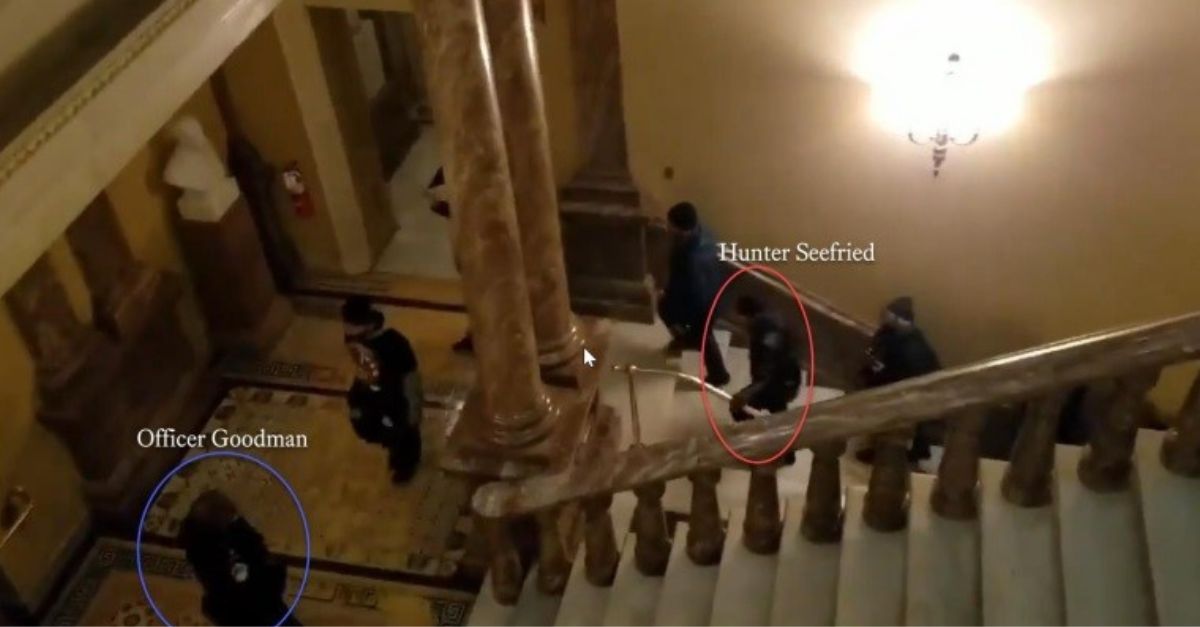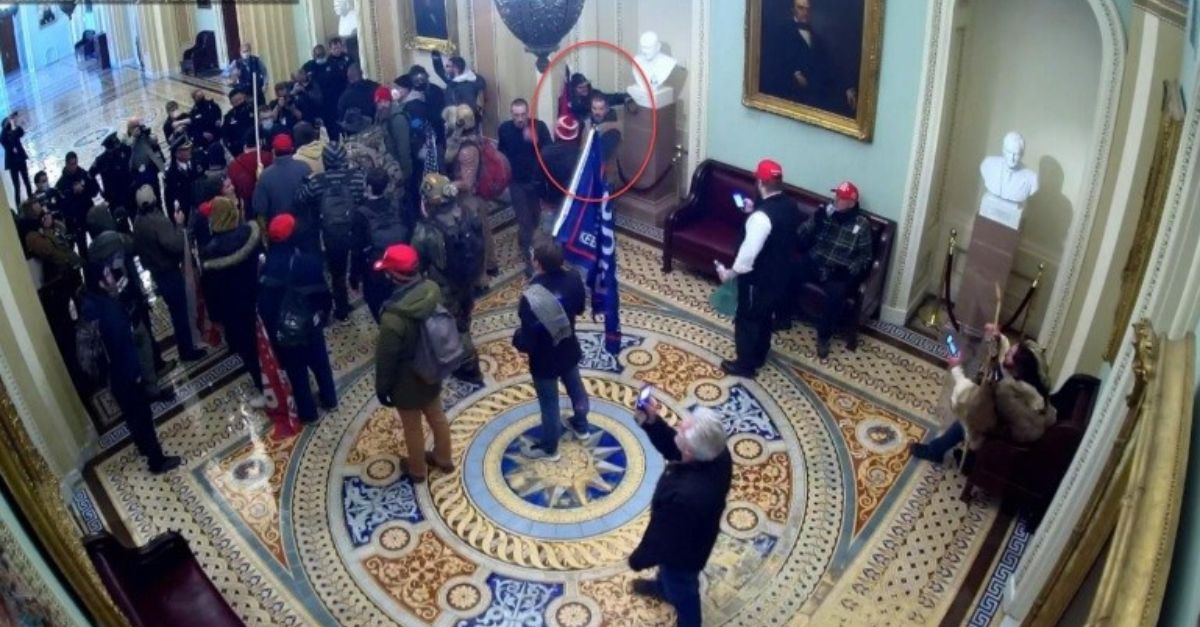
Kevin Seefried, left, carries a rolled-up Confederate flag which he later paraded through the U.S. Capitol on Jan. 6, 2021. His son, right, Hunter Seefried requested immediate release from prison and a sentence reduction in February 2024. (AP Photo/Manuel Balce Ceneta, File)
A man who joined with some of the first rioters to breach the U.S. Capitol on Jan. 6, 2021, with his Confederate-flag-waving father has asked a federal judge in Washington, D.C., to release him from prison immediately and to reduce his sentence.
Hunter Seefried, 24, made the request in a 13-page motion filed on Feb. 16. Hunter Seefried, who is from Delaware, is the son of Kevin Seefried, the 53-year-old man who carried a large Confederate flag through the halls of the Capitol before joining a group of rioters that chased U.S. Capitol Police Officer Eugene Goodman up several flights of stairs. Goodman led Seefried and others away from lawmakers still in the Senate chamber and toward waiting police.
Both of the Seefrieds were convicted by a federal judge at a bench trial in June 2022. Hunter Seefried was later sentenced to two years in prison while his father was sentenced to six. The men were found guilty of obstruction of an official proceeding, and four misdemeanor offenses, including entering and remaining in a restricted building or grounds; disorderly and disruptive conduct in a Capitol Building; disorderly conduct in a Capitol Building, and parading, demonstrating, or picketing in a Capitol Building, according to a statement from the Justice Department.
U.S. District Judge Trevor McFadden, a Trump appointee, acquitted Hunter Seefried on three charges. A Washington Post report noted that the defendant was effusive in his apologies to the court, calling Jan. 6 a “national embarrassment.”
McFadden was particularly struck by the young man’s mea culpa and called him a “good man who messed up badly.” Seefried, the judge said, at least recognized what he had done was wrong.
Seefried’s girlfriend and mother were also in the crowd that day and when McFadden asked Hunter Seefried why he didn’t just stay back with them but instead charged ahead with his father, he replied: “The crowd, the energy was just overwhelming. It’s no excuse. I would say my father, but I’m old enough to know.”
In a motion seeking a reduction to his two-year sentence, Hunter Seefried’s public defender says the man is eligible for it because even if they accepted the government’s version of his actions on Jan. 6, Seefried never necessitated aggression that rose to a “credible threat of violence.”
An adjustment was made to the sentence of another rioter, Tying Jing Yang, who made contact with police similarly. It was determined in Yang’s case that while he pumped his fist in the air, grabbed an officer’s baton, rushed toward a line of officers and obstructed their efforts to clear the Capitol, Yang did not act with a degree of aggression necessary to characterize it as violence.
“There is no dispute that Mr. Seefried did not physically touch Officer Goodman,” the motion states.
But prosecutors say because Seefried was in the vicinity of Goodman and contributed to his being chased down, it’s all the same in the end.

In a screengrab of footage from inside the U.S. Capitol on Jan. 6, 2021, convicted rioter Hunter Seefried contends his sentence should be reduced because he wasn’t posing a “credible” threat of violence to officers protecting the Capitol, namely, U.S. Capitol Police Officer Eugene Goodman pictured.
Hunter Seefried says he was “casual[ly] walking and peering around the Capitol in an exploratory fashion” which itself should undercut the government’s claim of violence meant to harm Goodman or others. The 24-year-old spent about 20 minutes inside the Ohio Clock Corridor on Jan. 6 agitating police, according to prosecutors, but the video the government produced at trial wasn’t sufficient to prove that, Seefried also argues.
There was police testimony at his bench trial that Hunter Seefried had “fists clenched” and that he was pacing in front of officers, the motion notes. But his lawyer contends that was an overblown assessment.
The fist clenching, for one, was Seefried trying to give a “thumbs up” while smiling at a nearby photographer, the motion states. The “agitating” of police was him talking to them, but not menacingly, he argues. He also holds that for much of the time he spent in the corridor, he effectively hung back and stood near a bust.

In this exhibit, Hunter Seefried says he is not posing a “credible threat of violence” to police inside the Capitol on Jan. 6, 2021.
“Stripped of its rhetoric, the government’s argument amounts to a thinly veiled attempt to repackage its “broad-guilt-by-association” interpretation,” wrote federal public defender A.J. Kramer.

Circled in red, Hunter Seefried says he hung back on Jan. 6 and stayed near a bust, not posing a “credible threat of violence.” Photo courtesy of court records in evidence.
As for a reduction in sentence, Kramer continued:
Although true that even if a defendant is eligible for a retroactive amendment, a court may still refuse to apply it, the government fails to identify any persuasive reason for why Mr. Seefried should not receive the benefit of the retroactively applicable Amendment 821. At sentencing, this Court believed ‘there are significant factors here in [Mr. Seefried’s] favor … and that stands in contrast to other defendants [the Court has] sentenced for felonious conduct on January 6th.’
It recognized that Mr. Seefried’s actions were ‘a complete aberration for [him].’ Id. It underscored that Mr. Seefried has ‘no criminal history, no association with extremist groups, and there’s no evidence that [he] had been planning to do anything like this before hand.’
The Court also noted his ‘good employment record and the many letters submitted on [his] behalf that testify to [his] good character,’ his youth, and found his
‘statements of remorse’ to be ‘probably the most sincere and the most affecting statements of anyone [the Court has] sentenced for behavior on January 6th in quite a while.’
Arguing that as a “zero-point offender,” he deserves the reduction, Kramer also urged the court to consider recent amendments to the U.S. Sentencing Commission guidelines. Had the new amendments existed when he was first sentenced, he would have been looking at a guideline range of 18 to 24 months instead of the 24 to 30 months the judge used as a guide.
Kramer says Seefried has obtained his GED while in prison and has been a “model inmate” who has taken classes and works in prison. He has also obtained his forklift operator certificate so when he is released, he can pursue work in that arena.
Seefried would like to be let out prior to his expected release date of April 3, 2024, and given credit for time served.
Have a tip we should know? [email protected]

